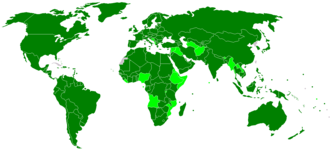Pakistan and the International Monetary Fund

Pakistan has been a member of the International Monetary Fund (IMF) since 1950.[2] Due to the unpredictable nature of its economy and its dependence on imports, the IMF has provided loans to Pakistan on twenty-two occasions, with its most recent being in 2019.[3]
History
Pakistan joined IMF in 1950 as newly established country was facing fiscal problems since its creation in 1947 from British India.
In 1958, for the first time, Pakistan went to IMF for bailout. For this, IMF lent out US$25,000,000 [originally the loan-amount is given in SDR;[4] for this article it is considered to be 1SDR = 1USD] to Pakistan on standby arrangement basis on 8 December 1958.[3] Pakistan again went to IMF in 1965. This time, IMF gave US$37,500,000 to war-torn nation on 16 March 1965.[3] Three years later, Pakistan again went to IMF for third time for balance of payment problems for which IMF gave US$75,000,000 on 17 October 1968.[3]
In 1971, Pakistan lost its Eastern half, East Pakistan, after the Bangladesh Liberation War. This war caused huge loses to Pakistan. For which, Pakistan got loan of US$84,000,000 in 1972, US$75,000,000 in 1973 and another of US$75,000,000 in 1974 to meet its growing needs.[3] In 1977, another standby arrangement of US$80,000,000 was made on urgent basis.[3] Three years later, an extended facility of US$349,000,000 was reached in 1980. Struggle of Pakistan continued, as Pakistan withdrew another US$730,000,000 as Pakistan was already part of US cold war against Soviet Union.[3]
Another era was started, as democracy came back to Pakistan but old ways to handle economy poorly continued. Benazir Bhutto government withdrawn US$194,480,000 as standby arrangement and another US$382,410,000 in shape of structural adjustment facility commitment on 28 December 1988.[3] In 1990, government of Nawaz Sharif decided against going to IMF instead arranged donations from friendly countries like Saudi Arabia.
In 1993, Benazir Bhutto again came to power and her government again went to IMF and reached an agreement to get standby arrangement of US$88,000,000 on 16 September 1993.[3] Poor handling of economy continued by her government as she got loan of US$123,200,000 under the extended fund facility and another US$172,200,000 were borrowed on 22 February 1994.[3] During that period economy of Pakistan remained in poor shape and Pakistan had to go to IMF again for record third in the period of Bhutto government.[3] As per few sources, this was the most corrupt government in the history of Pakistan. This time Pakistan got an amount of US$294,690,000 on 13 December 1995.[3]
In 1997, Nawaz Sharif came to power. Benazir Bhutto government was sacked on the corruption charges and left economy of Pakistan in worst shape. Sharif government went to IMF on urgent basis for the first time and reached an agreement to get two amounts of US$265,370,000 and US$113,740,000 on October 20, 1997.[3]
In 2008, Yousaf Raza Gillani received a $7.6 billion loan from the IMF.[5]
In 2018, Imran Khan became Prime Minister of Pakistan. For this, they arranged friendly loans from Saudi Arabia, United Arab Emirates and China to avoid tough IMF conditions.[6] In 2019, when economic conditions worsened, they went to IMF for the twenty-second time for a loan of US$1 billion.[7] IMF gave loan based on conditions such as hike in energy tariffs, removal of energy subsidy, increase in taxation, privatization of public entities and fiscal adjustments to the budget.[6]
References
- ^ Articles of Agreement of the International Monetary Fund, Article VIII – General Obligations of Members
Section 2: Avoidance of restrictions on current payments;
Section 3: Avoidance of discriminatory currency practices;
Section 4: Convertibility of foreign-held balances. - ^ "Pakistan and the IMF". IMF.
- ^ a b c d e f g h i j k l m "Pakistan has borrowed 21 times from IMF since Dec 8, 1958". www.thenews.com.pk. October 23, 2018.
- ^ "IMF Special Drawing Rights to US Dollar Exchange Rate Chart | Xe". www.xe.com. Retrieved 2022-04-09.
- ^ "Press Release: IMF Executive Board Approves US$7.6 Billion Stand-By Arrangement for Pakistan". www.imf.org.
- ^ a b "Is Pakistan on the way to living without the IMF?". www.cadtm.org. 11 June 2022.
- ^ Agency, Anadolu (May 16, 2019). "IMF bailout package — rescue or trap for Pakistan?". DAWN.COM.
